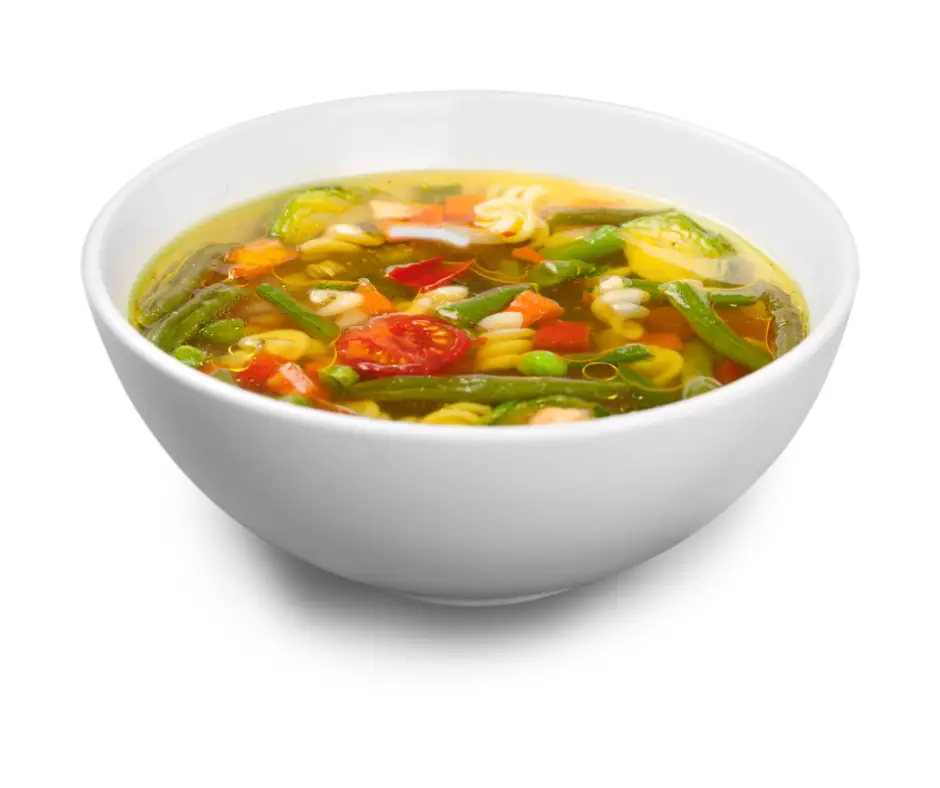Often mistaken for one another, minestrone soup and pasta fagioli are two Italian soup staples that stand as culinary symbols in their own right.
Still, the untrained eye (or palate) might struggle to distinguish these two comforting bowls.
In this article, we will stack the two soups side by side to help you understand just what sets them apart.

What Is The Difference Between Minestrone Soup and Pasta Fagioli?
To start with, minestrone is primarily a vegetable-based soup.
It often contains beans, though some variations might exclude them completely, as well as pasta or rice to thicken it up.
You’ll also find tomatoes and a vibrant mix of herbs adding depth of flavor to this Italian favorite. Some recipes even call for meat.
On the other hand, pasta fagioli – translating to “pasta and beans” in Italian – is typically thicker and creamier than minestrone.
Its main ingredients are a small variety of pasta such as elbow macaroni or ditalini with borlotti or cannellini beans as the primary protein source.
Tomatoes bring acidity to the dish while bacon, pancetta, sausage or beef add meaty richness.
However, just like minestrone, a vegetarian version can also be found. To add texture to this soup, different regions prefer either puréed or whole beans.
When it comes to consistency, both soups can range from thick and stodgy to brothy and light.
However, a wider assortment of vegetables including carrots, celery, zucchini, spinach, cabbage and potatoes make minestrone denser than its counterpart – which usually has very few veggies, typically onions, garlic and either celery or rosemary.
One surprising thing about these two soups is that neither has an absolute recipe.
In fact, the only main requirement for a soup to be called pasta Fagioli is that it must include both beans and pasta.
How It’s Made: Minestrone Soup Vs Pasta Fagioli
Minestrone Soup
Minestrone soup starts off by sautéing onion, garlic, celery, leafy vegetables and other forms of veggies like carrot and parsnip in a splash of olive oil.
Once these ingredients are beautifully caramelized, broth is added along with canned tomatoes, beans and a selection of dried herbs.
The symphony in this pot reaches its crescendo when it comes to a boil. This melodious mix is then allowed to simmer until the vegetables become perfectly tender.
Meanwhile, in a separate pot, either pasta or rice is cooked until it achieves an al dente texture – not too hard, not too soft.
Once drained, this is then added to the soup adding a delightful bite that contrasts with the softness of the vegetables.
It’s finished off with a sprinkle of salt, pepper and an optional dusting of cheese to taste.
Pasta Fagioli
Pasta fagioli takes an alternate route in preparation starting by browning some meat in olive oil (if you choose).
Once browned to perfection, the meat is drained and set aside while we borrow the same pot for more flavor infusion.
Here goes the trinity again- onion, garlic, celery along with carrots are cooked until they soften.
Adding tomato sauce, canned tomatoes and broth to this pot brings another level of flavor intensity that makes your kitchen smell heavenly.
Next, we add beans and allow them to simmer for about 10 minutes before introducing small al dente pasta into our soup.
This heartwarming dish concludes with seasoning it using salt pepper and cheese if desired.
Why Is Minestrone Soup Called Minestrone?
Minestrone soup owes its name to the vibrant Italian culture from which it originated.
Its name, ‘minestrone’, translates to either ‘big soup’ or ‘thick soup’, a title rightly earned through its rich and diverse ingredients.
The term minestrone is intricately woven from two Italian words or concepts.
Firstly, we have ‘minestra,’ translating to ‘soup’ – a word that stems from the verb ‘minestrare’.
In English, this means ‘to serve’ or ‘to administer’, quite fitting for an element of hospitality like food.
Coincidentally, it also shares roots with the English word minister, embodying the ideas of service and assistance.
Next is the crucial ‘-one’ suffix tagged at the end of ‘Minestr-one’.
This component isn’t merely an add-on but in Italian grammar serves as an augmentative suffix.
It amplifies or intensifies the preceding noun.
To illustrate this concept better, imagine ragazzo meaning ‘boy’ gets transformed into ragazz-one signaling towards a ‘big boy’ or ‘lad’.
In essence, when you say minestrone soup, you’re referencing a big or thick soup that is typically served as a prime course or an all-inclusive meal.

